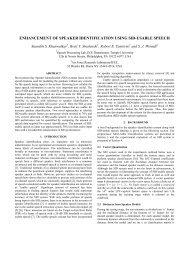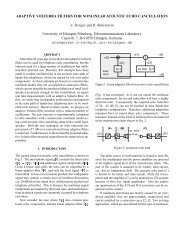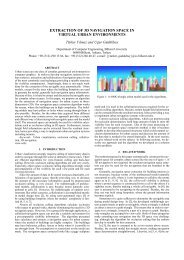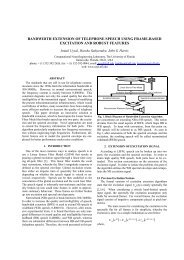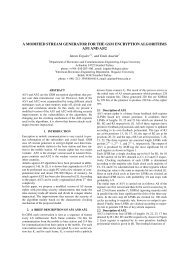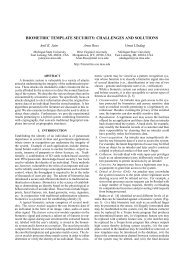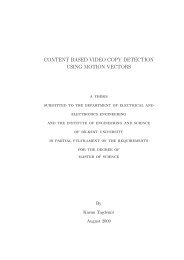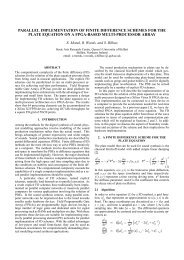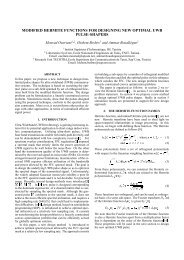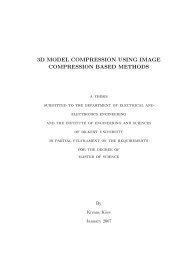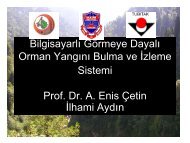VIDEO WATERMARKING FOR DIGITAL CINEMA CONTENTS
VIDEO WATERMARKING FOR DIGITAL CINEMA CONTENTS
VIDEO WATERMARKING FOR DIGITAL CINEMA CONTENTS
Create successful ePaper yourself
Turn your PDF publications into a flip-book with our unique Google optimized e-Paper software.
Video WatermarkingFor Digital Cinema ContentsSadi Vural, Hiromi Tomii, Hironori YamauchiRitsumeikan University, Department of Information Science,1-1-1 Noji-higashi, Kusatsu-shi, Shiga-ken, JapanEmail : {svv21002,re009994 ,yamauchi}@se.ritsumei.ac.jpAbstract— With the advent of digital cinema and digitalbroadcasting, copyright protection of video data has been one of themost important issues.We present a novel method of watermarking for video image databased on the hardware and digital wavelet transform techniques andname it as “traceable watermarking” because the watermarked data isconstructed before the transmission process and traced after it has beenreceived by an authorized user.In our method, we embed the watermark to the lowest part of eachimage frame in decoded video by using a hardware LSI.Digital Cinema is an important application for traceable watermarkingsince digital cinema system makes use of watermarking technologyduring content encoding, encryption, transmission, decoding and allthe intermediate process to be done in digital cinema systems.The watermark is embedded into the randomly selected movie framesusing hash functions.Embedded watermark information can be extracted from the decodedvideo data. For that, there is no need to access original movie data.Our experimental results show that proposed traceable watermarkingmethod for digital cinema system is much better than the convenientwatermarking techniques in terms of robustness, image quality, speed ,simplicity and robust structure.Keywords— Decoder, Digital content, JPEG2000 Frame,System-On-Chip, traceable watermark, Hash Function, Wavelet.W1. INTRODUCTIONITH the rapid spread of the Digital world in the field ofmovie Industry, many companies are starting to developequipments for digital cinema systems. Lately, Olympus Corphas developed digital video camera (SH-880TM) with 8Millionpixels [9] and Victor Corp developed D-ILA projector(DLA-HD2K) with 8million pixels compatible [10].In addition to two companies given above, NTT incorporated,Japan continues R&D using fiber optic networks for DigitalCinema networks and systems [11]. While companies areworking on, moviemakers in Hollywood are also starting tochange their current novel methods from analog tapes to digitalDVDs and/or Digital Medias at the crossway to digital. DigitalCinema initiatives in US work on specifications andstandardization for digital cinema [8]. In recent days theencoding specifications have been standardized as ISO/IEC15444-1:2000 Information Technology-Jpeg2000 [4] [5].Since far, many digital watermark techniques have beenproposed for digital cinema as a protection method [1] [2] [3]and many papers have been published and researches stillcontinue to find some security solutions for Digital cinema[6][7]. However, none of those is satisfactory for the eitherdigital cinema content providers or digital cinema clients. It isfundamental that the watermarking be robust against to everysignal processing methods and must be difficult to remove whenan attack has occurred. But the current methods are fragile toattacks. Some methods are robust enough but the image isdistorted by embedded watermark data.Based on those, we propose traceable watermarking method.We embed watermark at transmitter side as well as at Receiverside and then trace the watermark to make system sync work.In this research, we put the watermark twice to trace the videodata not only during the play at projection but also during thedata transmission, encoding and during the download processfrom Digital Cinema content server.The brief digital cinema architecture will be discussed at [2].The [3] gives the further details on proposed watermarkingtechniques including concrete design of encoder, decoder,traceable watermarking technology, consequently.The chapter [4] gives the experimental results of our research.The following chapter [5] will give a simple conclusion of theentire research and the last chapter is reference chapter.2. <strong>DIGITAL</strong> <strong>CINEMA</strong> SYSTEM ARCHITECTUREA. Entire Digital Cinema StageDigital Cinema is complete Hardware/Software systems whichmake its users enjoy full-length noise free moving pictures andhigh resolute cinema-quality in their homes using some digitaltechnologies over the high-speed networks.The Digital Cinema system delivers digitized, compressed, andencrypted movie contents to its users using some Electronictransmission methods. In Japan, High-bandwidth fiber opticcables for internet and cable TV are commonly used. With itsuse for Digital Cinema, clients can enjoy watching movie, getnews from live broadcasting with high resolute view..Security is another major issue for digital cinema systems sincemany problems come out while tape-based movie contents arereplaced by digital-based contents.Main security problems are such like data hacking, dubbing,reproduction of the licensed movie, external access to the clientserver and internal attackers. To come over those problems, weconstruct a total cinema system where it is formed by Data
Transmitter and Data Receiver by using hardware componentsas seen at Fig 1.encryption, compression, synchronization, packaging, networkauthentication. The watermark embedded at encoder sideprotects the content from the network attackers or hackersduring the content transmission while the watermark embeddedat Decoder side protects the media from content stealing andillegal dubbing.Watermarking data consists of the Content Administration ID,company name of the content supplier’s and the content owner.Watermark is inserted to the sub bands of the content framesusing DWT. Since the watermark embed does not vary for eachuser, the load of encoder is light, which makes encoder LSI runquick enough.Fig 1 Digital Cinema systemAs seen at Fig 1, there is a Cinema Server, where the contentdata is kept. This server includes a RAID system and it has somelarge storage where movie contents are stored. The service ofCinema Server can also be renamed as Video-On-Demand(VOD). Another service which digital cinema system providesis for live broadcasting service. For that, we need a highresolution Digital Video Camera placed which is placed outsideat Fig 1 above. Using it, the broadcasting data from camera isdirectly transmitted to the client side. Client is the service user.The data is controlled by a digital video data controller whichprovides an interface between the digital camera device andencoder & transmitter interfaces as seen at Fig 1.Authentication server connected to the Cinema serverauthenticates both the client who put a request to the server andthe transmitter, which is responsible for requested contenttransmission. Authentication sever takes important role whenthe client use the cinema system.The transmitter is a one-chip LSI, which is used for dataencoding, embedding watermark data, encryption and any othersub-processes needed during the transmission like data packing,load balancing of the network, data protocol selection.Likewise the transmitter, the Receiver is another one-chip LSI,which is built in receiver circuits. It decompresses, decodes,decrypts, and re-embeds the traceable watermark into a verycarefully calculated position on image. Receiver operates atuser side which has a direct connection to download server tosave the downloaded content. Default for receiver is to transferthe data to the projector to watch.The content data at download server is not possible to watchprior to decoding since a series of authentication, evaluation,decoding must be done before playing the content. For eachplay of the content from Download server, a new authenticationwith the server is requiredFig 2 Transmitter LSI with encryption methodJPEG2000 compatible transmitter is responsible for inputs fromboth the digitalized data from the Cinema server andwatermarking data at the same time. The plain content andWatermark data are added inside the Encoder by our Crc-32traceable watermarking method, which will be further explainedat chapter “3” (fig 2).Transmitter makes an output for watermarked content. Thewatermarked content is made an input to a SHS (stream headerscattering) so that frames are randomly distributed on the entirecontents. Information for watermarking to embed at transmitterpart is restricted into cinema server’s identification number,Content Proprietor name, and Date of Watermarking insertion.It is possible as large as 256-byte per each frame.Fig 3 Logic of the Watermark embed3. OUR PROPOSED <strong>WATERMARKING</strong> SOLUTIONThe Encoder LSI primarily handles on several works such as theembedding watermark to the encoded content, Encoding,
1 Proposed traceable WatermarkingFig 4 Traceable watermark applicationThe basic structure of our proposed traceable watermark isshown at Fig 4. According to the figure, the contents ofwatermark are the copyright information at transmitter side andthe broadcast information at receiver side. It is important thatconstant information such as transmitter ID, GPRS informationof the transmitter, content ID is embedded into the video contentto keep the transmitter load light. Doing it, the watermark to beembedded does not change for each user. Assume that contentinformation is embedded with different watermark information.Then the transmitter is heavily loaded and the data is delayedwhich causes a significant drop at overall system performance.However, watermark information embedded at receiver side isunique to each user. That does not affect the system since eachuser has one processor. The watermark information to embedinto the receiver side is the broadcast information as shown atFig 4. We embed the watermark into LL subbands and divideembedded subbands into the code blocks using the DWT attransmitter side. Receiver side is useful to embed due to theillegal recordings during play. Because data dubbing at receiverside is another problem. The basic algorithm for data embed isshown at Fig 6-(a), (b) and its embedding method by hashfunctions is given at Fig 52 RNG Based watermarking embeddingFig 6-(a) gives a general representation for Motion JPEG2000movie frames. RNG generates some random numbers for theautomatic frame selection while Fig6-(b) shows the frames interms of frame’s sub-bands. We use the low frequency levels ofthe image where is given as LL2, LH2, HL2, and HH2.The watermark is embedded into the image subbands after twosubdivisions of image frames. The second subdivision is lowfrequency region. The reason to work in low frequency regionsis because the low frequency levels of the image are robustagainst the common geometrical attacks. However it is also truethat image is distorted at high frequency levels but a securewatermarking is possible. We select the frequency region so thatwe get no disturbance at image and robust against the attacks.Fig 6 Watermarking Algorithm[A] Positioning for the embeddingFig 5 Transverse using CRC-32 Hash functionAt Fig 5, by using the hash function, we execute the traceablewatermarking. Hash Function generates constant length datafrom the input data. Obtaining the original data from hash datais almost impossible so showing its robustness against anyattack. SHA and MD are also robust but they need a series ofcomplicated calculations. We use CRC32 of the RFC1662. Theinput for CRC32 is called as “strings”, which has a variablestring length and generated 32-bit hash is called “CRC (string)”Fig6-(c) right side is the method of how we embed thewatermark into the content. The left side of the (c) is the positionof the watermark. First, a 4-16 digit Hash key is decided and its4x4 representation is drawn as seen at Fig 6-(c) right side. Foreach hash key, the 4x4 data cells are interchanged so that theoriginal location of the watermark is not determined.At Fig 6-(d), the same procedure as given at Fig 6-(c) is done forReceiver. It is because the watermarking information embeddedat transmitter side is not distorted or overwritten by theembedded watermark at receiver side. Therefore we use singleblocks at transmitter and even blocks at receiver. We embed thewatermark at decoder side to follow where and when the contentis played and we embed it at encoder side to prevent someunexpected effects done to the decoder side and thosewatermarks are embedded at once and at the same time.
To recover the watermark information from image, the hash keyis assigned in reverse and for each hash key, 4x4 data cells areinterchanged in opposite way. At Fig 6-(c) and Fig 6- (d),position initializator determines the coordinate (xe,ye) forencoder and (xd,yd) for decoder. It is the position where thewatermark information is embedded via Hash function.64x64/2=2048 dot (256byte) can be embedded for bothDecoder and Encoder. It is 128 byte for encoder and 128 bytefor decoder part, which gives a total 2048 dots.frequency components using hash function and calculate thevalue from (2) and obtain the watermark.2 Architecture of encoder[B]Embedding StrengthEncoder is embedded into the odd numbers of the sub-band anddecoder is done into the even numbers. This is given as below2nnnL = ( N × N )/2 ,(0 ≤x
4. EXPERIMENTAL RESULTSExperimental results show that proposed method is robustagainst any image processing.We did geometrical attacks (cut, crop and trim the one part of arandom selected frames, flip) and signal processing attacks(noise, hulman filtering, increase/decrease image quality,compress/decompress, apply FFT, DCT transformations).Tile size of 2560x2048 MotionJPEG2000 is used. For thesimplicity, we used 512x512 gray-scale images and divided into5 subband levels via wavelet transform. The Lowest subband is16x16. The total character size is 256byte to embed, whichmeans entire subband is used. The results are shown at Fig 10-b:Level 3A- JPEG Compression rate[%}Level 5Level 3Level 5Level 7Level 3Level 5Level 7Fig 10 Lena Image (512x512)We observed the embedding intensity and the image quality andobserved the changes on the image quality during ourwatermark insertion into the image sub bands. We learned howefficient our proposed method is during the watermark insertionand extraction. We set embedding intensity coefficient Q to 5and we set the level to 3 and 5.For experimental purposes, we also increased the watermarkinformation to 512byte at level 3 and we got high BER ratiosand the image was distorted with high compression rate and512byte information which is not allowed for 512x512 imagesunder normal conditions and QL=3 is not applicable for digitalcinema images.Table-1 BER values with IntensityB-JPEG2000 Compressionrate[%}Fig 11 Embedded Data under CompressionAt Fig 11 A-B, it is clear that when compression rate isincreased, BER is decreased Especially for JPEG 2000compression, the result becomes almost zero for furthercompression rates. Fig 11 gives that 5% of compression rate hasan ignorable BER and it is feasible to make it zero by errorcorrection. We continue tests using Stirmark and Checkmarkprograms to further investigate how robust our algorithm is.Some tests using Stirmark are given at Fig 12. Fig 12 (a-d)shows signal processing attacks. Images are applied sometransformations based on the signal processing effects.Above table shows the experimental results for JPEG andJPEG2000 compression in accordance with PSNR andQuantization Level (QL). It has been approved at digital cinemaexperiments that 5% compression rate for an image issatisfactory enough for the quality of digital cinema [12]. Hence,the results for QL≥5 satisfy the digital cinema requirementswhich also means that QL=3 is ignorable. Our experimentsshows Jpeg2000 compression gives better results comparedwith JPEG images and there is almost no error for QL=5 and 7.Fig 12 Stirmark test resultsFig 12 (a) is affine transform. (b) is Jpeg compression where theimage is compressed by 30%. (c) is a noise addition. Here, weadd noise and reduce color. Fig 12 (e-i) is geometric transform.
The target is to change the image size, rotation, crop and trimwhich relates of physical effects on images. The rest of theimages apply special transformations.Fig 13 is one frame image of live concert. It is watermarkembedded frame. Fig 13 (a),(b) are given as a result of croppingthe frames into small pieces. The watermark is kept inside. Nopart of watermark information is removed after cropping.(a) Small part is cropped(b) Some part is cropped(c) Significant part is cropped (d) almost all croppedFig 13 Image Crop AttackImage is cropped more from (a) to (d). (d) is almost cropped andit is hard to recognize the image. But the watermark we embed isstill visible and obtainable.(a) Rotate by 5% (b) Rotate by 10%enough against to signal transformations, geometrictransformations and filtering effects.5. CONCLUSIONIn this work, we have proposed traceable watermarktechniques based on the DWT for an application of digitalcinema systems and confirmed that the proposed watermarkmethod is robust enough against to signal processing attacks.The most general basic structure of Traceable watermarking isthat the watermark information embedded before transmissionand the watermarking information after transmission are keptsynchronous and even if one side of watermarking weredistorted, broken or changed, decoder LSI will never decode thecontent. If the watermark is attacked at receiver side, theencoder LSI will understand what has happened and stoptransmission immediately.Based on our tests and structural building of our algorithm, wecan say that our watermarking method is robust and safe enoughWe will further expand our experiments to the digitalizedhigh-vision movie for its further spread out in the industry andtest our algorithms using the recompiled Stirmark program andCheckmark for not only JPEG2000 motion pictures but also forMPEG4 more intensively.REFERENCES[1] Akio, Miyazaki, “Digital Watermarking for images”. IEICE Transactions.Fundamentals, Vol.E85-A,NO.3 March 2002, pp. 2.[2] N. J. Mathai, D. Kundur and A. Sheikholeslami, "HW ImplementationPerspectives of Digital Video Watermarking," IEEE Transactions onSignal Processing, vol. 51, no. 4, pp. 925-938, April 2003[3] Hisashi. Inoue, “A Digital Watermark method using the WaveletTransform for Video Data” ,IEICE Trans.Fundamentals,Vol.E83-A,No.1 Jan2000.[4] Suzuki, Junshi, “JPEG2000 Technology” by Ohm Publishing, Jan 2001.[5] Rohm Corp, “Jpeg2000 Coder LSI ” http://wwww.rohm.com[6] Xilinx Corp, “.Digital Cinema Applications” http://www.xilinx.com[7] “Rijndale” http://www.esat.kuleuven.ac.be/~rijmen/rijndael/[8] Digital Cinema Initiatives “ Digital Cinema System Specifications v2.0”,2003 , http://www.dcci.com[9] Olympus Corp, “R&D Center, IS Division Project , Planning Group”[10] Japan Victor Corp “ILA Center Division” http://www.victor.co.jp[11] NTT Telecommunications “Yokotsuka R&D Division”http://www.ntt.co.jp[12] NTT Electronics "Digital Cinema quality" http://www.ntt-west.co.jpSadi Vural was born at Corum/Turkey and after getting hisB.S degree in Istanbul University at 1997, He started toScience and Information Technology of RitsumeikanUniversity Kyoto/Japan. He got his M.S at 2000 and he isnow studying for Ph.D Degree while working for Takumivision Technologies, Inc,Osaka/Japan.(c) Rotate by 30% (d) Rotate by 90%Fig 14 Rotation attackDiffering from Fig 13, Fig 14 gives an attack using rotationtechniques. Most of watermarking technology starts failing after30% rotation. Using our method, it is not impossible to get thewatermark and distort the image. All of those tests results doneas shown at Fig 11-13 show that our traced algorithm is robustHiromi Tomii has obtained her B.S from Ritsumeikan University at 2003 andcontinued for M.S degree in the same university. She joined at YamauchiResearch room and did researches in the field of Watermarking technology.After she obtained her M.S degree at 2005, she left University to work. She isnow working for Konica Co.Inc Tokyo/JapanHironori Yamauchi was born at 1950 in Fukui-ken/Japan. After he obtainshis M.S from Tokyo University at 1975, he started to work for NTT Corp.He joined at Ritsumeikan University Kusatsu/Japan in 1996. He is currently achairman of Rohm Plaza, an LSI Design cenrter.His field covers Multimedia image, Hardware design, VLSI development andMedical imagings. He is a member of IEEE Society.




